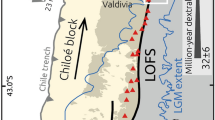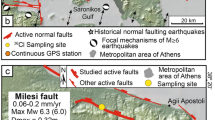Abstract
The magnitude 7.8 Gorkha earthquake in April 2015 ruptured a 150-km-long section of the Himalayan décollement terminating close to Kathmandu1,2,3,4. The earthquake failed to rupture the surface Himalayan frontal thrusts and raised concern that a future Mw ≤ 7.3 earthquake could break the unruptured region to the south and west of Kathmandu. Here we use GPS records of surface motions to show that no aseismic slip occurred on the ruptured fault plane in the six months immediately following the earthquake. We find that although 70 mm of afterslip occurred locally north of the rupture, fewer than 25 mm of afterslip occurred in a narrow zone to the south. Rapid initial afterslip north of the rupture was largely complete in six months, releasing aseismic-moment equivalent to a Mw 7.1 earthquake. Historical earthquakes in 1803, 1833, 1905 and 1947 also failed to rupture the Himalayan frontal faults, and were not followed by large earthquakes to their south. This implies that significant relict heterogeneous strain prevails throughout the Main Himalayan Thrust. The considerable slip during great Himalayan earthquakes may be due in part to great earthquakes tapping reservoirs of residual strain inherited from former partial ruptures of the Main Himalayan Thrust.
This is a preview of subscription content, access via your institution
Access options
Subscribe to this journal
Receive 12 print issues and online access
$259.00 per year
only $21.58 per issue
Buy this article
- Purchase on Springer Link
- Instant access to full article PDF
Prices may be subject to local taxes which are calculated during checkout



Similar content being viewed by others
References
Avouac, J.-P., Meng, L., Wei, S., Wang, T. & Ampuero, J.-P. Lower edge of locked Main Himalayan Thrust unzipped by the 2015 Gorkha earthquake. Nature Geosci. 8, 708–711 (2015).
Hayes, G. P. et al. Rapid characterization of the 2015 Mw 7.8 Nepal (Gorkha). Earthq. Seism. Res. Lett. 86, 1557–1567 (2015).
Lindsey, E. et al. Line of sight deformation from ALOS-2 interferometry: Mw 7.8 Gorkha earthquake and Mw 7.3 aftershock. Geophys. Res. Lett. 42, 6655–6661 (2015).
Galetzka, J. et al. Slip pulse and resonance of the Kathmandu Basin during the 2015 Gorkha earthquake, Nepal. Science 349, 1091–1095 (2015).
Grandin, R. et al. Rupture process of the Mw = 7.9 2015 Gorkha earthquake (Nepal): insights into Himalayan megathrust segmentation. Geophys. Res. Lett. 42, 8373–8382 (2015).
Wang, K. & Fialko, Y. Slip model of the 2015 Mw 7.8 Gorkha (Nepal) earthquake from inversions of ALOS-2 and GPS data. Geophys. Res. Lett. 42, 7452–7458 (2015).
Denolle, M. A., Fan, W. & Shearer, P. M. Dynamics of the 2015 M7.8 Nepal earthquake. Geophys. Res. Lett. 42, 7467–7475 (2015).
Elliott, J. R. et al. Geometry of the Main Himalayan Thrust. Nature Geosci. 9, 174–180 (2016).
Bilham, R., Larson, K., Freymueller, J. & Project Idylhim members. GPS measurements of present-day convergence across the Nepal Himalaya. Nature 386, 61–64 (1997).
Ader, T. et al. Convergence rate across the Nepal Himalaya and interseismic coupling on the Main Himalayan Thrust: implications for seismic hazard. J. Geophys. Res. 117, B044403 (2012).
Avouac, J. P. Mountain building, erosion, and the seismic cycle in the Nepal Himalaya. Adv. Geophys. 46, 1–80 (2003).
Bilham, R. Earthquakes in India and the Himalaya: tectonics, geodesy and history. Ann. Geophys. 47, 839–855 (2004).
Sapkota, S. N. et al. Primary surface rupture of the great Himalayan earthquakes of 1255 and 1934. Nature Geosci. 6, 71–76 (2013).
Bollinger, L. et al. Estimating the return times of great Himalayan earthquakes in eastern Nepal: evidence from the Patu and Bardibas strands of the Main Frontal Thrust. J. Geophys. Res. 119, 7123–7163 (2014).
Kumar, S. et al. Paleoseismic evidence of great surface rupture earthquakes along the Indian Himalaya. J. Geophys. Res. 111, B03304 (2006).
Bettinelli, P. et al. Seasonal variations of seismicity and geodetic strain in the Himalaya induced by surface hydrology. Earth Planet. Sci. Lett. 266, 332–344 (2008).
Fu, Y & Freymueller, J. Seasonal and long-term vertical deformation in the Nepal Himalaya constrained by GPS and GRACE measurements. J. Geophys. Res. 117, 2156–2202 (2012).
Bilham, R. Location and magnitude of the 1833 Nepal earthquake and its relation to the rupture zones of contiguous great Himalayan earthquakes. Curr. Sci. 69, 101–127 (1995).
Bilham, R. & Wallace, K. Future Mw > 8 earthquakes in the Himalaya: implications from the 26 Dec 2004 Mw = 9.0 earthquake on India’s eastern plate margin. Geol. Surv. India Spl. Pub. 85, 1–14 (2005).
Mugnier, J.-L. et al. Structural interpretation of the great earthquakes of the last millennium in the central Himalaya. Earth Sci. Rev. 127, 30–47 (2013).
Wallace, K., Bilham, R., Blume, F., Gaur, V. K. & Gahalaut, V. Surface deformation in the region of the 1905 Kangra Mw = 7.8 earthquake in the period 1846–2001. Geophys. Res. Lett. 32, L15307 (2005).
Avouac, J.-P. From geodetic imaging of seismic and aseismic fault slip to dynamic modeling of the seismic cycle. Ann. Rev. Earth Planet. Sci. 43, 233–271 (2015).
Jackson, M. & Bilham, R. Constraints on Himalayan deformation inferred from vertical velocity fields in Nepal and Tibet. J. Geophys. Res. 99, 13897–13912 (1994).
Satyabala, S. P., Yang, Z. & Bilham, R. Stick–slip advance of the Kohat plateau Pakistan. Nature Geosci. 5, 147–150 (2012).
Scholz, C. H. & Campos, J. The seismic coupling of subduction zones revisited. J. Geophys. Res. 117, BO5310 (2012).
Feldl, N. & Bilham, R. Great Himalayan earthquakes and the Tibetan plateau. Nature 444, 165–170 (2006).
Stevens, V. L. & Avouac, J. P. Interseismic coupling of the Main Himalayan Thrust. Geophys. Res Lett. 42, 5828–5837 (2015).
Schiffman, C., Bali, B. S., Szeliga, W. & Bilham, R. Seismic slip deficit in the Kashmir Himalaya from GPS observations. Geophys. Res. Lett. 40, 5642–5645 (2013).
Ambraseys, N. & Jackson, D. A note on early earthquakes in northern India and southern Tibet. Curr. Sci. 84, 570–582 (2003).
Bollinger, L., Tapponier, P., Sapkota, S. N. & Klinger, Y. Slip deficit in central Nepal: omen for a repeat of the 1344 AD earthquake? Earth Planets Space 68, 1–12 (2016).
Acknowledgements
Details of support from NSF EAR 1345136, 1546636 and 1261833 and NASA and from numerous organizations and individuals that made the measurements possible are found in the Supplementary Information. We especially thank J.-P. Avouac for his important role in working with the Ministry of Mines and Geology in Nepal to install and maintain the Nepal GPS network and the NSF-operated UNAVCO facility for supporting the rapid response.
Author information
Authors and Affiliations
Contributions
All authors gathered the data. J.G. directed GPS instrumentation and telemetry. D.M. analysed the GPS data. R.Bendick, D.M. and R.Bilham undertook the elastic modelling and wrote the article.
Corresponding author
Ethics declarations
Competing interests
The authors declare no competing financial interests.
Supplementary information
Supplementary Information
Supplementary Information (PDF 4785 kb)
Rights and permissions
About this article
Cite this article
Mencin, D., Bendick, R., Upreti, B. et al. Himalayan strain reservoir inferred from limited afterslip following the Gorkha earthquake. Nature Geosci 9, 533–537 (2016). https://doi.org/10.1038/ngeo2734
Received:
Accepted:
Published:
Issue Date:
DOI: https://doi.org/10.1038/ngeo2734
This article is cited by
-
Dalit’s livelihoods in Nepal: income sources and determinants
Environment, Development and Sustainability (2023)
-
The stop-start control of seismicity by fault bends along the Main Himalayan Thrust
Communications Earth & Environment (2021)
-
Building the Himalaya from tectonic to earthquake scales
Nature Reviews Earth & Environment (2021)
-
Combination of the Levenberg–Marquardt and differential evolution algorithms for the fitting of postseismic GPS time series
Acta Geophysica (2021)
-
Frictional and structural controls of seismic super-cycles at the Japan trench
Earth, Planets and Space (2020)



